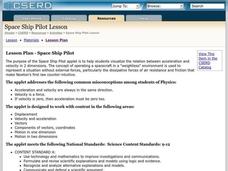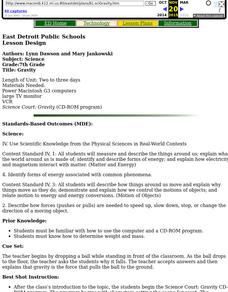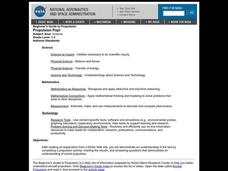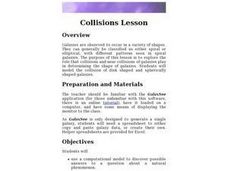Curated OER
Sky and Cloud Windows
Young scholars monitor the weather, clouds, and sky. In this weather lesson, students create a sky and cloud window to focus their sky observations. They write observations in a notebook and include the date, time, cloud cover, types of...
Curated OER
Impulse and Momentum
Students are introduced to the concepts of impulse and momentum and problem solving strategies for these types of problems. In groups, they discover the law of conservation of momentum and share their answers with the class.
Curated OER
Space Ship Pilot
Students visualize the relationship between acceleration and velocity as they maneuver a model spaceship in a 2-dimensional applet.
Curated OER
Gravity
Seventh graders progress through the Science Court: Gravity CD-ROM program. They read about and discuss how gravity was discovered. They complete review worksheets in preparation for the test.
Curated OER
Aircraft Trajectory Problem Set
Students, after reading an explanation from a NASA Web-based textbook, demonstrate an understanding of the text by applying it to the calculation of speed, distance, acceleration, and time in simple aircraft motion.
Curated OER
Newton's 2nd Law
Fourth graders discuss Newton's Second Law of Motion, and the acceleration of fast and slow moving objects. They experiment with items with different masses to determine the effect mass has on acceleration using a toy car. They complete...
Curated OER
Taking Risks: Drug and Alcohol Abuse
Students discuss a video about drug and alcohol abuse and their connection to risk-taking. They answer questions on a risk factor sheet about the use of tobacco, drugs, and alcohol. They discuss long and short term goals and how not...
Curated OER
Propulsion Pop!
Young scholars demonstrate an understanding of the text by completing a propulsion activity, charting the results, and answering questions that demonstrate an understanding of rocket propulsion.
Curated OER
Doing Science: Computer Models
In this computer models worksheet, students read information about how scientists use computer models to advance the work of science. Students also answer a critical thinking question comparing computer simulations to direct observations.
Curated OER
Ocean Shoreline
In this shorelines worksheet, students review some of the features of an ocean shoreline such as barrier islands, longshore current, and shoreline sediments. This worksheet has 5 matching and 4 short answer questions.
Curated OER
Collisions Lesson
Tenth graders explore the role that collisions and near collisions of galaxies play in determining the shape of galaxies. They model the collision of disk shaped and spherically shaped galaxies.
Curated OER
Scrambled Eggs Anyone?
Students listen to Nursery Rhymes highlighting GRAVITY, pull ropes during a Rope Pull Activity and even drop eggs from a height during a Gravity Contest. This is a fantastic lesson which highly motivates Students!
Curated OER
Swings
Young scholars investigate variables which may seem to affect the movement of a pendulum, or "swing."They interpret their observations and apply the scientific principles to develop explanations and solve a new problem.
Curated OER
Attract or Repel?
Opposites attract with a fun science experiment on magnets. With a short paragraph on background knowledge, the lab sheet prompts third and fourth graders to choose which pairs of magnets will attract, and which pairs will repel. A...
Rochester Institute of Technology
Skateboard Performance Testing
Perform an activity on performance testing with a activity focused on the purpose of wheel bearings on skateboards. Learners conduct performance testing on a skateboard to collect and interpret data.
DiscoverE
Kicking Machine
Don't kick the resource to the curb; you'll definitely regret it. Future engineers devise a kicking machine that launches a ping-pong ball toward a target. They can use a pendulum, a rubber band, or both, depending on whether they want...
Curated OER
The Law of Inertia
Young scholars practice the 4 question strategy to form more questions and develop further experiments. The four questions are engage, explore, explain, and elaborate. They use the 4 question strategy on an investigation involving the...
Curated OER
Heat Up the Floating Plates
Eighth graders research the connection between the convection currents within the mantle of the earth and the moving of Earth's plates. A connection to lessons at previous grade levels on the rock cycle and important background...
Curated OER
Wig-wag Physics
Learners make observations on the effects of a small, medium and large weight on the movement of a wig-wag apparatus. They use their observations to develop a generalized inference of the effect weight on movement patterns.
Curated OER
Opposites Attract
Students demonstrate the attraction of small pieces of paper to a charged plastic rod and conduct experiment with other objects to determine whether they can hold a charge. They then use online applets to apply their experiments to...
Curated OER
Energy Conversion
Sixth graders study energy conversions. They watch a demonstration of a working engine and make a chart explaining the energy conversions taking place. They build a simple electric motor and research other types of electric generators.
Curated OER
Simple Machines
Ninth graders are shown a constructed machine and they asked what it is and what it does? They are questioned on type of simple machine constructed. Students are questioned on various parts of machine. They work in groups to design...
Curated OER
Reflecting Light
Students are introduced to the reflective properties of light and use mirrors to make light from a source reflect onto a specific target. They take turns and record the amount of time it took to correctly reflect the light.
Curated OER
Virial Theorem Lesson
Ninth graders describe how equilibrium can occur as the balance of two effects. They model the stability of elliptical galaxies based on how fast stars within the galaxy are moving.























